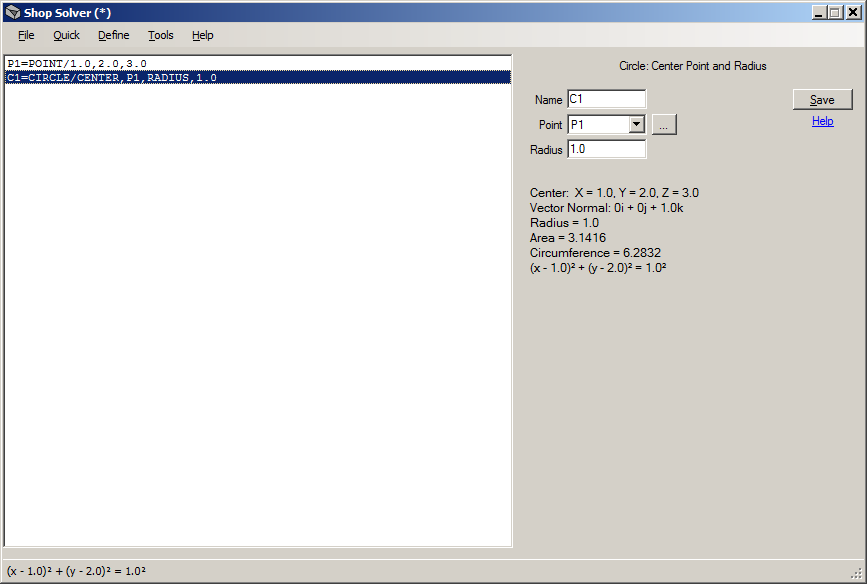Shop Solver
Define Commands
The
Define commands provide comprehensive methods for defining a wide
assortment of geometric types and operations upon them.
Definitions are modeled in the style of APT geometric
statements. (APT is a computer language for programming
numerically controlled
tools. APT knowledge/experience is not required to use Shop Solver.) In some cases Shop Solver's implementation is different from APT as described in Note 2 below.
Shop
Solver evaluates definitions in real-time. For example, if you
define a point as the intersection of 2 lines then the point's
coordinate is calculated as soon as the point definition is saved.
Point
Line
Circle
Plane
Cylinder
Ellipse
Vector
Sphere
Hyperbola
Pattern
The figure below shows an example of a definition tool:

The
left side of the tool is the list of currently defined geometrics
stored in memory. A point and a circle are defined and the circle
definition is selected. The circle's definition is:
C1=CIRCLE/CENTER,P1,RADIUS,1.0
The
right side of the tool shows how the circle is defined. The
definition title is "Circle: Center Point and Radius". This
definition has 3 fields: Name, Point and Radius. The Name field defines the circle's name, the Point field defines the center point of the circle, and the Radius field is the circle's radius. The Name field is a simple text field. The Point field is a drop-down list from which you can select any currently defined points. The Radius field is a numeric input field called an "Expression Box." It, and all numeric input fields in Shop Solver, can evaluate mathematical expressions such as (1+2)*3 and sqrt(3^2+4^2).
Click the Help link for an explanation of the current definition and its fields.
This
circle definition has a reference to a point which must be defined
first. The "..." button to the right of the Point field is called
the Nest Button. You can use the Nest Button
whenever an appropriate geometric has not already been defined.
It displays a menu of definition commands appropriate
to the geometric being selected. In this case a menu of
point definition commands appears. Selecting an item on the menu
takes you directly to that definition tool. After saving that
definition you are returned to the current definition tool with the new
geometric already selected. To return to the previous definition tool without saving press the Escape key.
After filling in all of the definition fields and clicking the Save
button, the geometric's metrics are displayed below the
definition fields. The metrics area displays whatever metrics are
appropriate to the defined geometric. The mathematical equation
is also shown for most geometrics.
To
edit an existing geometric double-click its definition in the list on
the left. To delete a definition right-click on it and select
"Delete" from the pop-up menu (see Note 1
below). To copy all definitions in the list to the clipboard
right-click anywhere in the list and select "Copy All" from the pop-up
menu. To plot the definitions right-click anywhere in the list and select "Plot" from the pop-up menu.
Note 1
Shop
Solver maintains a list of backward references for all geometric
definitions. A reference is when a geometric definition refers to
another previously defined geometric. A definition cannot be
deleted if another definition is referencing it. For example, in
the figure above circle C1 has a reference to point P1. Therefore
P1 cannot be deleted until all definitions referencing it are deleted
(in this case circle C1).
In addition, modifying a referenced geometric automatically
updates the geometric referencing it. In this example C1 is
automatically updated when the definition of P1 changes.
Note 2
Shop Solver does not require or use an APT compiler.
Shop
Solver and APT differ in how some geometrics are stored and operated
upon. For example, a line in APT is treated as a plane
perpendicular to the XY plane. Shop Solver defines a line as
passing through 2 points in 3-space. The difference manifests
when finding the intersection of 2 lines. For example, the
perpendicular lines in the following definitions are both at Z1.0:
L1=LINE/0,0,1.0,1.0,0,1.0 $$ 1 unit above the X axis
L2=LINE/0,0,1.0,0,1.0,1.0 $$ 1 unit above the Y axis
P1=POINT/INTOF,L1,L2
In APT the coordinate of point P1 is X0 Y0 Z0. In Shop Solver P1 is at X0 Y0 Z1.0.
Another
difference is in how circles are treated. APT defines a circle as
a cylinder perpendicular to the XY plane. Shop Solver makes no
such assumption. Again, the different implementations sometimes
yield different results when intersections are calculated. And
there may be other differences in how various geometrics are treated.
